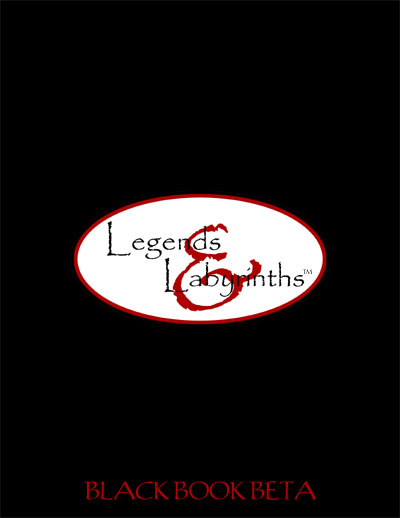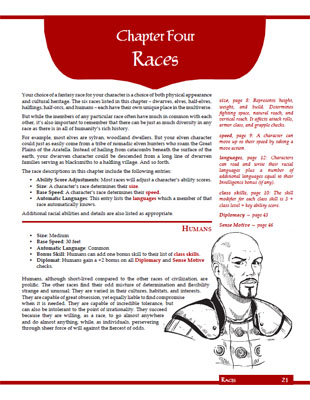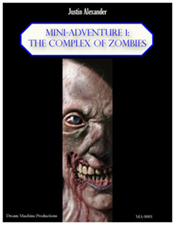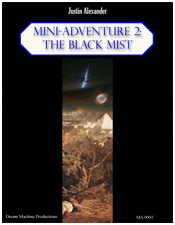Legends & Labyrinths includes a hazard creation system. It gives the DM a toolset for quickly designing treacherous obstacles, deadly environments, and breakneck challenges. Creating a hazard is a quick, four-step process:
- Pick a Challenge Rating
- Define Area/Targets
- Define Effect
- Define Defense
Basically, you define the specific scope of the hazard by setting its CR. Then you can refer to the Hazards table on page 86 of the rulebook — which includes General Check DCs, Trained Check DCs, Save DCs, Attack Bonuses, Attack Damage, Repeating Damage, and One-Shot Damage to mechanically define the specifics of the hazard.
PUTTING IT THROUGH ITS PACES
A couple days ago I did a 15 Minute Conversion Test to show off the speed and flexibility of the monster creation system by converting a half dozen encounters from the Caverns of Thracia. While performing the conversion test, I noticed this encounter key from area 1:
The air in the room stinks of bat guano and hanging from the ceiling are several hundred normal bats. The ceiling, which is 30′ high, is covered with them. The bats will be mildly irritated by torches but a Light spell will send them winging about through the air, severely agitated. The guano on the floor makes it slippery and will require a saving throw on a d20 of under the character’s Dexterity +2 per turn spent running through the muck or per round spent fighting in it. Failure to make the throw indicates slipping and falling into the goo.
Let’s say we wanted to model this slippery bat guano in Legends & Labyrinths. Like Jaquays you could just pluck some reasonable-sounding numbers out of the air, but you could also turn to the Hazards system for guidance. If you did, it would look something like this:
1. PICK A CHALLENGE RATING: The rulebook suggests, “In general, a hazard with a challenge rating equal to the average level of the party represents a danger that the party can routinely handle with little risk. (So if anybody plucked off the street could deal with it, the hazard is probably a CR 1. If it’s something that requires a good deal of skill or luck to endure, it might be a CR 5 hazard. If it’s something that only legendary heroes could expect to encounter and survive, on the other hand, you’ll want to start looking at a challenge rating of 10 or more.”
This seems like something most people should be expected to handle. Let’s make this a CR 1 challenge.
2. DEFINE AREA/TARGETS: The bat guano covers the floor in areas 1, 2, and 3. It also covers the last 20′ of the stairs leading down to area 1.
3. DEFINE EFFECT: The bat guano will render a character prone. We’ll check the Hazard Effects table on page 87 to see if the prone condition requires a minimum CR (it doesn’t).
4. DEFINE DEFENSE: Quoting from the rulebook again, “Characters within the area affected by a hazard or targeted by a hazard generally get some defense against the hazard’s effect. (…) Saving Throw: If a hazard does not need to make an attack roll, a character affected by the hazard is allowed to make a saving throw. Choose the type of saving throw which is most appropriate for the hazard’s effect. (…) Action Check: For some hazards, a character may be able to make skill or ability checks in order to interact with the hazard or bypass it without suffering its effects.”
So we’ve got a couple of options here. We could require a Reflex save from anyone moving through the area (in which case we’d look at the Hazards table and see that the Save DC for a CR 1 Hazard is DC 12). But I think it probably makes more sense to require anyone hustling, running, or fighting in the bat guano to make a Balance check. Looking at the Hazards table, we’ll pull the General Check DC (used for “any action check which needs to be made by every character in the party”). A CR 1 hazard has a General Check DC 14.
And that’s pretty much it. Our final hazard looks like this:
Bat Guano (CR 1): Covers the last 20′ of the stairs and areas 1, 2, and 3. Balance check (DC 14) or fall prone.
ADDING SOME BATS
But what about those bats that are swooping around?
The first question I’m going to ask is: How much of a pain-in-the-ass do I want those swarming bats to be? At the low end, we could say that they effectively dazzle characters in their midst (-1 penalty on attack rolls, Search checks, and Spot checks). At the high end, we could say that they’re entangling characters (move at half speed, cannot run or charge, -2 penalty on attack rolls, -4 penalty to Dexterity, casting spells requires a Concentration check).
Checking the Hazards Effects table I see that there’s no minimum CR for hazards that dazzle, but entangling hazards have a minimum CR 2.
Let’s go ahead and make ’em a real pain in the ass. Some of these bats are just one step removed from being dire bats (they’re related to their larger cousins in the caverns below) and until they get into the open air they’re basically a solid wall of flapping terror.
Although this isn’t a trap, we’ll grab the concept of a trigger from the trap rules to simulate provoking the bats (“certain natural hazards may also possess some or all the characteristics of a trap). Then we’ll set this as a CR 3 hazard requiring a Fortitude saving throw. We check the Hazards table for the CR 3 save DC and get:
Bat Swarm – Entangling (CR 3): Effects the stairs and areas 1, 2, and 3. Trigger (light spell or other strong light source). Fortitude save (DC 14) or entangled. Duration 1d4+2 rounds.
Another option would be have the bats actually physically batter those caught in their area. Using the rules for mixing CR effects, we could keep the DC 14 Fortitude save (a CR 3 effect) to avoid taking 1d6 damage (the repeating damage for a CR 1 hazard). Since these are the significant contributions to the hazard, you simply average the CR values to give you:
Bat Swarm – Battering (CR 2): Effects the stairs and areas 1, 2, and 3. Trigger (light spell or other strong light source). Fortitude save (DC 14) or 1d6 damage. Duration 1d4+2 rounds.
Alternatively you can combine multiple effects into a single hazard by simply combining CRs like any other encounter (using the rules on page 15):
Bat Swarm Totality (CR 4): Effects the stairs and areas 1, 2, and 3. Trigger (light spell or other strong light source). Fortitude save (DC 14) or 1d6 damage and entangled. Duration 1d4+2 rounds.
USING IT IN PLAY
Where the hazard systems really comes into its own, in my opinion, is during play. It provides you with general guidelines for appropriate action check DCs, saving throw DCs, and damage for characters of any given level.
That’s useful all by itself. But it also gives you a simple structure for rapidly facilitating improvisation by you and your players.
For example, let’s say the PCs want to weaken the support beams for a balcony and then lure a large monster onto the balcony so that it will collapse. Call for some appropriate action checks to prep the trap. Once its set-up you just need to set a CR and everything else will pretty much flow from that single decision point:
CR 7. Therefore, Balance check DC 22 for a PC to scamper across it without triggering the trap prematurely. When the unwitting monster hits it, it’s 7d6 points of damage (CR 7 one-shot damage) with a Reflex save (DC 17) for half damage.
(Maybe you set the CR based on check result of the action check the PCs use to set the trap.)
You’ll find some similar, non-improvised hazard creation tucked away in the Equipment chapter. For example, the description of wire includes:
Tripwire: A properly secured wire can serve as a CR 1 hazard. Characters can make a Spot check (DC 14 or opposed by the ambusher’s Hide check) to spot the wire. If they fail, they must make a Reflex save (DC 12) or fall prone.
The system is just too simple and versatile not to use.

CLIMB INTO YOUR LABYRINTH AND FORGE YOUR LEGEND TODAY!
















